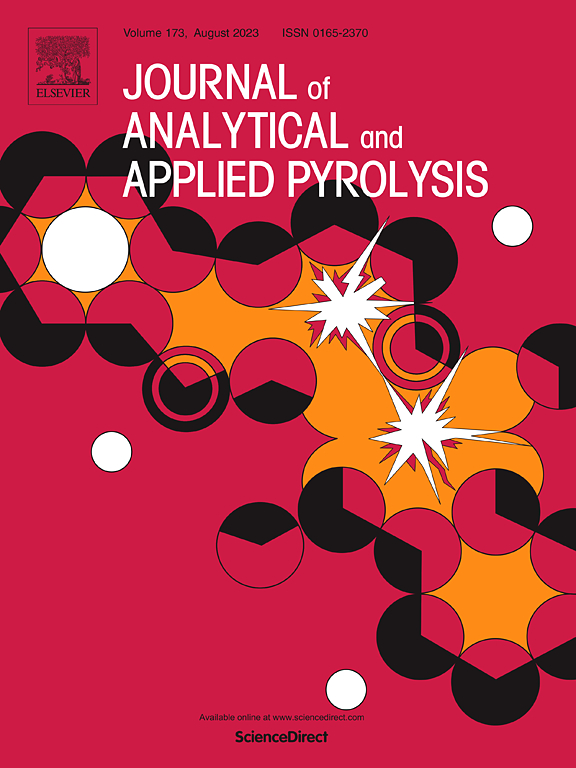探索活性炭催化热解生物质中可再生苯酚的选择性
IF 5.8
2区 化学
Q1 CHEMISTRY, ANALYTICAL
引用次数: 0
摘要
由于氢脱氧不完全,常见的生物燃料,例如醇醚氧合燃料,在空气中容易氧化,并偏离其燃烧效率和排放特征。酚类抗氧化剂可以通过利用过氧自由基大大提高生物燃料的氧化稳定性。活性炭(AC)是一种高效的选择性苯酚生产催化剂,即使不需要任何表面改性或金属负载。然而,由于在制备过程中孔隙通道和天然活性位点的演化是耦合的,因此在反应过程中仍然很难检测到孔通道和天然活性位点的单独贡献。本文设计了一个巧妙的实验,通过比较三种代表性的AC催化剂来解耦它们的贡献,其中K-AC和Z-AC具有平行的孔径分布(平均孔径为1.896 nm和1.837 nm),而Z-AC和P-AC具有平行的酸性活性位点。结果倾向于这样一个事实,即苯酚的选择性似乎主要取决于活性位点,其中酸性活性位点比碱性活性位点更有效,而与酸度强度无关。P-AC和Z-AC具有相似的苯酚选择性(67.24 %对65.52 %)。此外,孔径分布发挥了“形状选择性催化”的作用,似乎主要有助于苯酚收率,而不是苯酚选择性。因此,P-AC的苯酚产量几乎是Z-AC的六分之一。总的来说,这项研究为解释ACs在催化或其他高价值应用中的机制提供了一种有希望的方法。本文章由计算机程序翻译,如有差异,请以英文原文为准。
Exploring the selectivity of renewable phenol from catalytic pyrolysis of biomass via activated carbon catalyst
Due to incomplete hydrodeoxygenation, common biofuels, for examples alcohol-ether oxygenated fuels, is prone to oxidation in air and deviates its combustion efficiency and emissions profile. Phenolic antioxidants can substantially raise the oxidative stability of biofuels via the tapping of peroxy radicals. Activated carbon (AC) emerges as efficient catalysts for selective phenol production, even without any surface modification or metals loading. However, it’s still difficult to detect solo contributions of pore channel and native active sites in AC catalysts during reactions, due to their evolution are coupled when preparation. Herein, an ingenious experiment was designed to decouple their contributions via the comparison of three representative AC catalysts, where K-AC and Z-AC possess parallel pore size distribution (average pore size of 1.896 nm vs. 1.837 nm), while Z-AC and P-AC possess parallel acidic active sites. Results tend to the truth that phenol selectivity seems mainly dependent on active sites, where the acidic active site is more efficient than the basic, while little relevant with acidity strength. P-AC and Z-AC showed similar phenol selectivity (67.24 % vs. 65.52 %). Additionally, pore size distribution that performed the role of “shape-selective catalysis” seems mainly contribute to phenol yield, rather than phenol selectivity. So that, the phenol yield in P-AC is almost one-sixth more than Z-AC. Overall, this study provides a promising approach to interpret the mechanism of ACs in catalysis or other high value applications.
求助全文
通过发布文献求助,成功后即可免费获取论文全文。
去求助
来源期刊
CiteScore
9.10
自引率
11.70%
发文量
340
审稿时长
44 days
期刊介绍:
The Journal of Analytical and Applied Pyrolysis (JAAP) is devoted to the publication of papers dealing with innovative applications of pyrolysis processes, the characterization of products related to pyrolysis reactions, and investigations of reaction mechanism. To be considered by JAAP, a manuscript should present significant progress in these topics. The novelty must be satisfactorily argued in the cover letter. A manuscript with a cover letter to the editor not addressing the novelty is likely to be rejected without review.

 求助内容:
求助内容: 应助结果提醒方式:
应助结果提醒方式:


